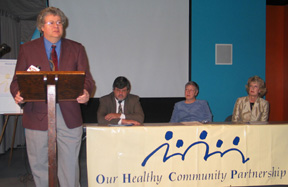Douglas County received its health report card last week, and the grades weren’t good. The report card showed that Douglas County has negative health trends occurring in each of nine identified areas.
 |
B.J. Reed, Ph.D., dean of the College of Public Affairs and Community Service at the University of Nebraska at Omaha and chairman of Our Healthy Community Partnership (OHCP), speaks at a Friday press conference. Seated behind Dr. Reed are, from left, David Filipi, M.D., a physician representing the Metro Omaha Medical Society, Susan Boust, M.D., a psychiatrist at UNMC, and Adi Pour, Ph.D., health director of Douglas County Health Department. |
At a news conference Friday at the Omaha Children’s Museum, several representatives of Our Healthy Community Partnership (OHCP) laid out some of the major areas that need improvement. These areas include:
- Douglas County’s chlamydia rate is 34 percent above the national average, and its gonorrhea rate is 50 percent above the national average.
- Six out of 10 adults in Douglas County are overweight, including 23.6 percent who are considered obese.
- The age-adjusted cancer death rates in Douglas County are slightly higher than the national average.
- In Douglas County, 52.6 percent of men aged 40 and older have had some sort of prostate exam in the past two years compared to the national rate of 69.9 percent.
- Nearly 27 percent of Douglas County adults have suffered from some depression for two or more years compared to the national average of nearly 24 percent.
“This is a great opportunity for the community to see what issues are effecting its health,” said B.J. Reed, Ph.D., dean of the College of Public Affairs and Community Service at the University of Nebraska at Omaha and chairman of OHCP.
Founded in 1996, OHCP is a 30-member group consisting of Omaha area hospitals, insurers, managed care companies, medical schools and other private and public health agencies and organizations. The vision of OHCP is to make the community a better place to live, work, raise a family and enjoy life.
“The report card is just a snapshot of the health trends that are happening in Douglas County,” said Kerri Peterson, executive director of OHCP. “It will take our entire community, both on an individual and group level, to take responsibility for improving the health status of our community. These trends must start to change.”
The OHCP community health assessment was conducted, looking at reported health behaviors and perceptions of quality of life. The survey identified nine key community health improvement areas – cancer, diabetes, heart disease and stroke, infant health, lung disease, sexually transmitted disease, mental health and substance abuse, violence and abusive behavior, and activities designed for youth.
OHCP created a measurement system to mark progress in each of these areas. The measurement system views the community’s health through the use of indicators, which place a numerical measure on quality of life.
The process involved a broad range of stakeholders who helped develop the indicators for the nine key areas. The report card provides the most current data available in each area as well as the community’s vision for what it hopes to accomplish by 2010. The indicators will be monitored and reported annually.
“These trends and indicators need to play a part within the mission and vision of every organization in Douglas County,” said Adi Pour, Ph.D., health director of Douglas County Health Department.
The indicators will serve as a springboard for community discussions to identify methods that work and implement long-term change strategies, Dr. Pour said. They also serve as a tool for education and strategic thinking.
“As the indicators developed, we discovered something important — nearly every health trend is interrelated,” Peterson said. “Douglas County is a great place to live and has a wealth of resources. However, our most valuable resource lies within us — our community. This is an exciting opportunity to begin community-wide surveillance of the nine key community health improvement areas.
“OHCP will act as the catalyst and will strive to bring the community together, but we are just one piece of the puzzle. It will take the efforts of everyone to realize our vision. It is our hope that our entire community will adopt these indicators for both personal and strategic action.”
Dr. Reed said, “We are asking members of the community to consider the following questions: Which of these indicators can I and my organizations impact? How do the indicators relate to our strategic mission and vision? What is my commitment as a leader to positively affect the trends shown by the indicators? It is only when we begin to work on these areas as an entire community that we will begin to make an impact.”
In addition to Drs. Reed and Pour, other OHCP representatives presenting at the news conference were David Filipi, M.D., a physician representing the Metro Omaha Medical Society, and Susan Boust, M.D., a psychiatrist for the University of Nebraska Medical Center.
Member organizations of Our Healthy Community Partnership include: Alegent Health, Blue Cross & Blue Shield of Nebraska, Boys Town National Research Hospital, Children’s Hospital, Clarkson College, Creighton University, Creighton University Medical Center, Charles Drew Health Center, Chicano Awareness Center, Douglas County Commissioners, Douglas County Health Department, Methodist Health System, Metro Omaha Medical Society, Mutual of Omaha, Nebraska Medical Center, Nebraska Methodist College, Omaha Public Schools, Omaha Community Foundation, One World Community Health Center, Planned Parenthood of Nebraska and Council Bluffs, Sarpy/Cass County Department of Health and Wellness, Union Pacific Railroad, United HealthCare of the Midlands, United Way of the Midlands, University of Nebraska at Omaha, University of Nebraska Medical Center, Urban League of Nebraska, Inc., Visiting Nurse Association, Wellness Council of the Midlands, and YWCA Omaha.